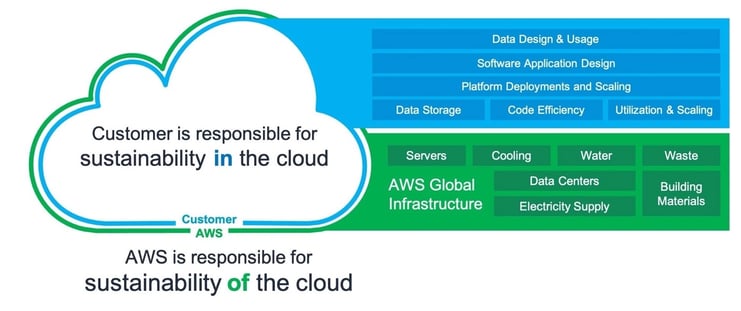The new AWS Sustainability Pillar - what does it mean for you?
/4.png?width=200&name=4.png)
UN research indicates that by 2030 the ICT industry is likely to account for 8% of total electricity demand — a 15-fold increase from 2010 — and that with annual global carbon emissions of around 6% since 2007, the ICT industry’s environmental impact is on par with the aviation industry.
It’s no wonder that 88% of IT leaders say their company needs to do a better job at IT sustainability. Many have tackled this issue with cloud adoption: moving from their own, on-prem and energy hungry data centres to cloud can help companies shave between 30% and 90% off their carbon emissions. Cloud providers have taken huge steps to making data centres as efficient as possible: using renewable energy, implementing water conservation and maximising the use of server capacity
Whilst migrating workloads to cloud can help organisations to take advantage of these cloud-provider led sustainability initiatives and hyperscale efficiencies (for an excellent summary, see this Nature article), there is also a responsibility on IT leaders to ensure that their applications are architected sustainably too.
In recognition of the growing strategic importance of ESG and commitments to a NetZero Future, in late 2021 AWS introduced it as a new, sixth, pillar to their Well Architected Framework. This embeds sustainability into best practices for application design, making sure the environmental impact of each design decision is considered. This also means that existing applications can be assessed for sustainability improvements as part of a Well Architected Review, alongside recommendations to make your application more secure, cost optimised or reliable.
When building cloud workloads, the practice of sustainability is understanding the impacts of the services used, quantifying impacts through the entire workload lifecycle, and applying design principles and best practices to reduce these impacts...
- AWS
Sustainability of the cloud, and sustainability in the cloud
Much like its approach to security, AWS is taking a shared responsibility approach to sustainability. AWS is responsible for the sustainability of the cloud, and AWS’ customers are responsible for sustainability in the cloud:

With their shared responsibility model for security, AWS builds all the doors and locks but you still need to turn the key to secure your applications. With this new pillar AWS services are built with sustainability options, but how they are implemented is down to the design of your application. So what are the levers you can pull to make an application more sustainable?
What makes an application more sustainable?
From AWS’ perspective, sustainable application design means “optimising workloads and resource utilisation, and minimising the total resources required to be deployed for your workloads.”
In practice, this means asking questions like:
- Is your compute infrastructure correctly sized for your needs? Reducing idle resources and maximising utilisation is key here - do you really need two hosts running at 30% utilisation, when one host running at 60% utilisation is a more efficient use of baseline power consumption?
- Does it use Autoscaling to scale up and down to meet demand, rather than consuming enough resources to meet peak demand constantly? In AWS you can even use machine-learning driven predictive auto-scaling, which can help you identify unexpected patterns and new ways to optimise.
- Are you making use of spare AWS capacity for large processing jobs with flexible start/end times? In AWS this is known as a Spot Instance, where you essentially rent unused capacity from AWS. By using spare capacity rather than provisioning on-demand resources, you’re able to save up to 90% on cost and also reduce the energy required to run your workload.
- How efficient is your data storage? Tools such as Intelligent Tiering can automatically move infrequently accessed data to cold storage, and for archiving there are options like Amazon S3 Glacier or S3 Glacier Deep Archive.
There is also a cost benefit to these practices, as lower consumption often results in lower spend.
The way in which your application arrives on the cloud will have an impact on the extent to which you can answer these questions. A fully cloud-native application will be more sustainably architected than one which was simply rehosted via a ‘lift and shift’ approach. This is why it’s important not to treat public cloud like another data centre, and to think of any migration as a starting point for improving resource, cost and service utilisation.
Want to learn more about sustainability in the cloud? Book a free consultation with one of our AWS Certified Practitioners.
